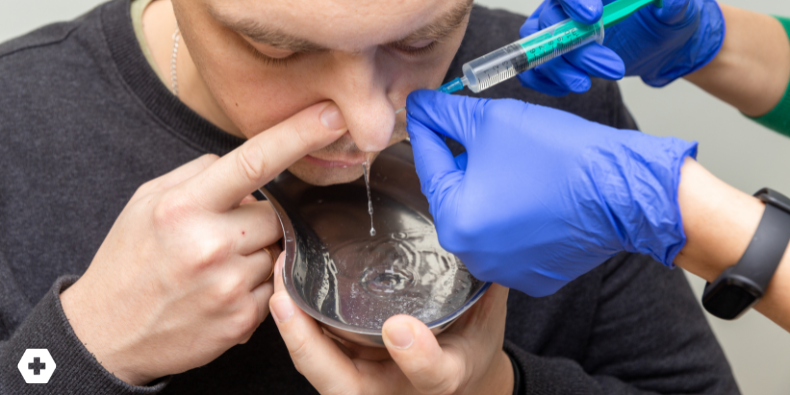
Sinus Rinses: Relief in a Bottle—If You Do It Right
If you’re a seasoned urgent care clinician, chances are you've had a patient ask about sinus rinses. Maybe they heard about neti pots from a friend, or maybe they’re desperate for relief after yet another round of congestion. As common as these devices are, they’re often misused, sometimes in ways that can cause more harm than good.
To help you feel more confident recommending (or cautioning against) sinus rinse kits, here’s a quick guide to when they help, how to use them safely, and what to tell patients before they start.
Why—and When—Sinus Rinses Help
Let’s start with when they make sense. If your patient is battling chronic sinusitis, allergic rhinitis, or even an acute sinus infection, sinus rinses can be a helpful adjunct. Think of it as house-cleaning for the sinuses: rinsing out mucus, reducing the load of allergens or bacteria, and adding moisture when dry air is taking its toll.
Recent research backs this up. A recent study found that nasal saline irrigation, used in conjunction with intranasal corticosteroids, was more effective in alleviating all symptoms of allergic rhinitis compared to intranasal corticosteroids alone. A meta-analysis of multiple studies found that saline irrigation significantly reduces disease severity in both short-term (up to 4 weeks) and longer-term (4 weeks to 3 months) periods, with large beneficial effects compared to both no treatment and placebo.
Rinses won’t magically cure infections, but they can reduce the germ load and inflammation that makes your patient miserable. It’s supportive care, and for the right patient, it really helps.
Getting It Right: Safe Solutions and Smart Devices
There’s one golden rule of sinus rinses: no tap water. Ever. Tap water can contain microorganisms that are harmless to swallow but dangerous if introduced into the nasal passages. Instead, patients should use distilled or sterile water, or tap water that has been boiled for at least three minutes and then cooled. Filtered water that meets NSF standards also works.
While pre-packaged saline mixes are the easiest option, patients can also make their own by combining medical-grade, iodine-free salt and baking soda. But make sure they avoid store-brand versions that may contain impurities. A typical mix is three teaspoons of salt to one teaspoon of baking soda—use one teaspoon of this mix in eight ounces of safe water.
As for devices? Neti pots, squeeze bottles, and bulb syringes are all effective options. The best device is the one your patient is willing and able to use correctly.
The Technique: Small Tweaks, Big Difference
Have your patient lean forward over the sink and turn their head to the side. Gently squeeze or pour the saline into the top nostril and let it drain out the other side. Remind them to breathe through their mouth, keep their mouth open, and not tilt their head backward (unless they enjoy saline dripping down their throat). Repeat on the other side, then gently blow the nose.
Some patients instinctively hold their breath or tense up. That can increase ear discomfort. Encourage them to breathe normally and to spit out any solution that runs into the throat.
What About Kids?
Rinses aren’t ideal for kids under 2—they’re not going to tolerate them well, and the risk isn’t worth it. For infants and toddlers, recommend a saline spray and a suction bulb. For older kids, pediatric rinse kits are available and work well with a little coaching (and parental supervision).
How Often Is Too Often?
During allergy season or an acute infection, daily or twice-daily rinses can offer real relief. But more isn’t always better. Overuse can irritate nasal passages, leading to more congestion, stinging, or even nosebleeds. Encourage patients to scale back once symptoms improve.
Common Pitfalls to Watch For
Here’s a rundown of frequent mistakes and how to head them off:
-
Using tap water. Just don’t.
-
Rinsing with plain water (ouch).
-
Trying to rinse with a blocked nose—wait until at least one nostril is passable.
-
Tossing rinse devices in the dishwasher (it won’t clean properly).
-
Reusing devices for years—replace every 3 months.
Also, educate patients about the difference between nasal sprays and rinses. Sprays moisturize. Rinses clean. They’re not interchangeable.
The Bottom Line
Sinus rinses can be a game-changer when used correctly. They relieve symptoms, improve the effectiveness of nasal medications, and help patients feel better faster. But a quick in-clinic demonstration—or even just a solid explanation can make all the difference between relief and regret.
Practice-Changing Education
Experience education that goes beyond theory. Explore Hippo Education’s offerings below.



